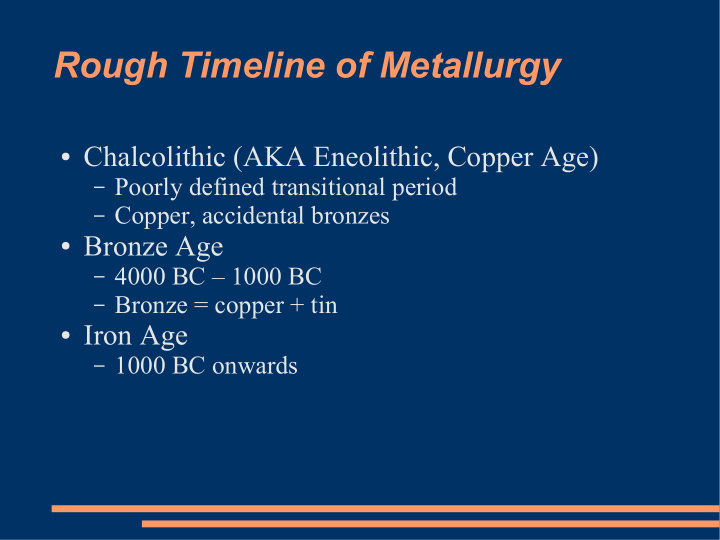



Rough Timeline of Metallurgy ● Chalcolithic (AKA Eneolithic, Copper Age) – Poorly defined transitional period – Copper, accidental bronzes ● Bronze Age – 4000 BC – 1000 BC – Bronze = copper + tin ● Iron Age – 1000 BC onwards
Basic Smelting Chemistry ● Very little native metal in the world – Gold, platinum, some copper, meteoric iron ● The rest is in the form of oxides, sulfides, etc. ● Smelting at its most basic: 2CuO + C = 2Cu + CO2 ● Need heat and a reducing atmosphere
Timna ● Earliest archaeological record of smelting ● ~4000 BCE ● Simple bowl furnaces with goat-skin bellows
Backyard copper smelting
Global source of tin
Iron ● Iron ore is everywhere ● Early furnaces were nowhere near hot enough to melt iron ● Instead, a porous mass called a bloom forms ● Contains lots of chunks of charcoal and slag ● Removed from the furnace and then hammered down to force out some of the impurities ● Very labor intensive
http://www.bradford.ac.uk/archsci/depart/resgrp/amrg/Rievaulx02/Rievaulx.htm
Flickr user: Stellar Muddle
Wrought Iron ● Resulting wrought iron has banded layers of differing carbon content, making it moderately resistant to corrosion ● In modern terms, 'mild steel' ● Don't confuse the name with wrought iron as a style of metalwork ● Distinctive 'grain' pattern if you know what to look for
Flickr user: neilalderney123
Blacksmithing ● Two basic operations: – drawing out: making longer and narrower (easy) – upsetting: making thicker and shorter (hard) ● Welding is possible at very high temps ● But riveting is easier and preferred if possible ● Surprisingly easy to do in an urban setting :)
Cast iron ● Takes very high temps, so you need good bellows or a good power source ● First achieved in China around 300 BCE ● China used box-bellows ● Added water power around 30 AD ● Didn't spread to Europe until the 15 th century ● Europe stuck with accordion bellows, which suck
Steel smelting ● Wootz ● Tamahagane ● Blister steel ● Crucible steel (1740) ● Puddling (1784) ● Bessemer Process (1855) (Youtube Video) ● Linz-Donawitz process (1952)
Steel chemistry ● Steel == alloy of iron + carbon ● Anything beyond about 1% carbon just makes it brittle – this is what cast iron is ● Different molecular structures at different temps – Ferrite: Pure iron, body-centered cubic lattice, low carbon solubility – Cementite: Iron carbide, brittle cast iron – Austenite: Face-centered cubic lattice, high carbon solubility – Martensite: Metastable result of rapidly cooled austenite – Pearlite: Combination of ferrite and cementite
Phase diagram
Heat treatments ● All heat treating of steel is just manipulation of the phase diagram ● Normalizing/annealing == slowly cooling from over the critical temp to release stresses and remove all hardening ● Quenching == rapidly cooling to lock the steel into martensitic structure ● Tempering == partially degrading hard/brittle structures through the application of (much lower) heat (martensite to cementite)
Quenching Myths ● The ONLY function of the quenchant is to change how quickly the steel cools down ● The faster it cools down, the harder and more brittle it will be ● Different quenchants remove heat at different speeds, due to bubble formation and boiling point ● Oil < water < brine ● Use the correct quenchant for the alloy, RTFM ● USING SNOW IS BULLSHIT
Case Hardening ● Pack the piece in carbon and heat for a long time ● Much like blister steel, but non-destructive ● Creates a high carbon zone maybe 1 mm deep ● Good for bearing surfaces, but not blades
Composite sword design ● The ideal blade has a very hard edge, but is still flexible over the whole length ● Can approximate this with tempering ● Another way is to combine steels of different carbon contents ● This also lets you use lower carbon steel, which traditionally was much cheaper ● Classic example: the katana ● (The folding 10,000 times thing? Bullshit.)
Differential quenching and hamon ● To make the edge even more durable, you can quench different parts at different rates ● Coat the parts you want softer with a clay mixture ● When quenched, those parts cool slower, thus harden less ● Forms a hamon when polished properly
References ● The Machinery's Handbook ● The Craft of the Japanese Sword, Leon Kapp and Hiroko Kapp ● Out of the Fiery Furnace: The Impact of Metals on the History of Mankind, Robert Raymond ● A History of Metallurgy, R.F. Tylecote ● Chalcolithic Copper Smelting: Excavations and Experiments, Archaeo-Metallurgy IAMS monograph, Beno Rothenberg, R.F. Tylecote, P.J. Boydell ● Sources of Tin and the Beginnings of Bronze Metallurgy, James D. Muhly, American Journal of Archaeology, Vol. 89, No. 2. (Apr., 1985), pp. 275-291. ● De Re Metallica, Georgius Agricola, translated by Herbert Hoover ● http://www.archaeology-classic.com/ ● And, of course, Wikipedia
Recommend
More recommend